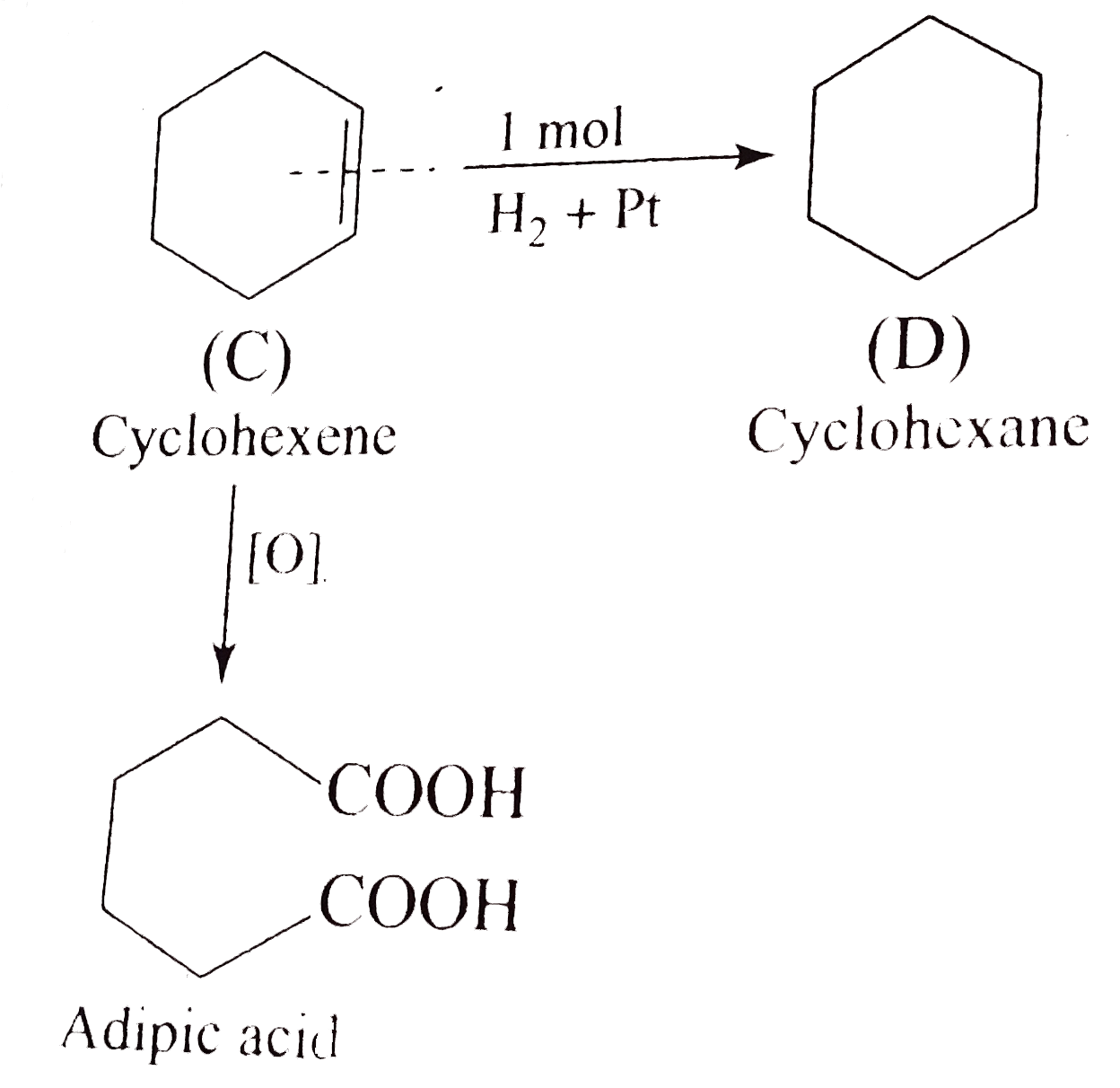Identify A, B, and C.
A, B, and C(C6H10)Br2/CCI2−−−−−−→All decolourisesBr2solution
Cold−−−−−−−→conc.H2SO4 All are soluble
(A)Ammoniacal−−−−−−→AgNO3 White precipitate
(AandB)excess−−−−−→ofH2/Pt Hexane
(C)1mol−−−→H2/PtD(C6H12)
(A)Hotalk.−−−−→KMnO4 Pent anoic acid only
(B)Hotalk.−−−−→KMnO4 Propanoic acid only
(C)Hotalk.−−−−→KMnO4 Adipic acid only
Video Solution
Text Solution
DU in A, B, and C=(2×6+2)−102=27∘.
Structure of (A):
(A) reacts with ammoniacal AgNO3 solution, which shows that it is a terminal alkyne with straight chain of six C atoms (because on hydrogenation it gives hexane). Therefore, (A) is hex-1-yne.

Structure of (B):
(B) does not react with [Ag(NH3)2]⊕ and hence it must be internal alkyne with straight chain of six C atoms (because on hydrogenation it gives hexane).
Location of triple bond is determined by oxidative cleavage. As it gives propanoic acid (3C-atom acid), it should be symmetrical internal alkyne.
Therefore, (B) is hex-3-yne.

Structure of (C):
It absorbs 1 mol of H2 and the product (D) (C6H12) after catalytic hydrogenation has 1 DU. So (D) must be a 6C-atom cyclic compound. Therefore, (C) is cyclohexene.

|
Topper's Solved these Questions
- ALKYNESBOOK - CENGAGE CHEMISTRYCHAPTER - ALKYNESEXERCISE - Exercises (Subjective Type)
31 Videos
- ALKYNESBOOK - CENGAGE CHEMISTRYCHAPTER - ALKYNESEXERCISE - Exercises (Linked Comprehension Type)
51 Videos
- ALKYNESBOOK - CENGAGE CHEMISTRYCHAPTER - ALKYNESEXERCISE - Exercises (Archives - Analytical and Desriptive Type)
4 Videos
- ALKENES AND ALKADIENESBOOK - CENGAGE CHEMISTRYCHAPTER - ALKENES AND ALKADIENESEXERCISE - Single correct Answer
14 Videos
- APPENDIX - INORGANIC VOLUME 1BOOK - CENGAGE CHEMISTRYCHAPTER - APPENDIX - INORGANIC VOLUME 1EXERCISE - chapter-7 Single correct answer
1 Videos
Similar Questions
Knowledge Check
CH3−C≡C−CH3H2−−−−−−→Pd−BaSO4
(A) Br2−−→CCl4(B)AMesoBRacemic mixtureCDiastereomersDAllPh−CH3∣C∣OH−Ph∣C∣OH−PhConc−−−→H2SO4 Product is
APh−CH3∣C∣OH−Ph∣C∣OH−CH3BPh−C∣∣O−C∣∣O−PhCCH3−C∣∣O−Ph∣C∣Ph−CH3DPh−C∣∣O−C∣∣O−CH3CH3−C≡C−CH3Na−−−−→liq.NH3(A)cold.KMnO4−−−−−−−→(B)
AMesoBRacemic mixtureCDiastereomersDAll
HNO3/H2SO4−−−−−−−−→ANaOH−−−−−→433KB, B is

View SolutionCH3−C≡C−CH3H2−−−−−−→Pd−BaSO4(A)D2−−→Ni(B)
Product (B) of above reaction is
View Solution3HC≡CHred hot−−−→Fe(A)CH3COCl−−−−−→AlCl3(B)Ni/H2−−−→25∘CC+D
Relation between C and D
View SolutionSuccinic acid Δ−−→(A)NH3−−−−−→Δ(B)Br2−−−−−→KOH(C), Product (C) will be :
View Solution2Ph−O∣∣C−CH3Mg−Hg−−−−→H2OConc.H2SO4−−−−−−−→ΔKMnO4H⊕−−−−−−−→
The final product is
View Solution

